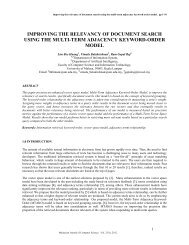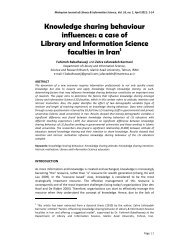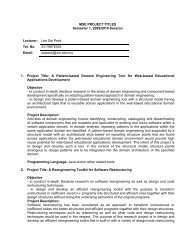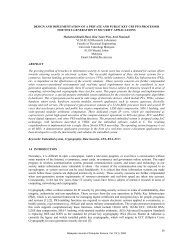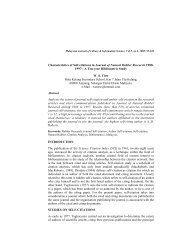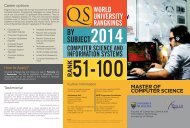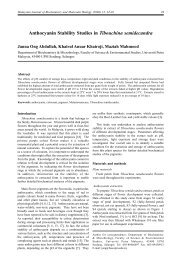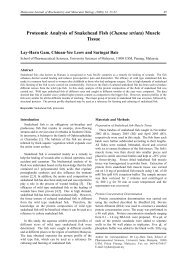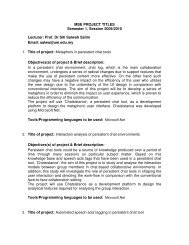Download1 - EJUM - Universiti Malaya
Download1 - EJUM - Universiti Malaya
Download1 - EJUM - Universiti Malaya
You also want an ePaper? Increase the reach of your titles
YUMPU automatically turns print PDFs into web optimized ePapers that Google loves.
48 Annals af Dentistry, University af <strong>Malaya</strong>, Val. 16 2009SUMMARY: The Malay females are notconsidered as an ethnic variation in regards to CPA,they can be treated the same way as the Caucasian~ inregards to that angle. CPA should be considered inconstructing fiX:~d and/or removable pro~thesescombined with the use of semi-adjustable articulators;this would enhance and improve the quality of thetreatment given to the patient. Clinicians should notdepend on the average values to which the simplearticulators are set. .Protrusive record method for programming thesemi-adjustable articulators can be reliable if modifiedby using efficient bite registration material and makingit reproducible by making use of the protrusive guide.Prevalence of Risk Factors for theDevelopment of Oral Mucosal Lesionsamong Or,ang AsH in MalaysiaIntan Suraiya Merican Aljunid MericanDepartment of Oral Pathelogy,Oral Medicine and ~eri~dontologyRisk habits such as smoking, alcohol'consumption andbetel quid chewing have long been identified asprimary risk factors in causing many'severe diseasesand cancers, Glutathiony S-transferase (GST), a PhaseII enzyme, is important in the detoxification andex~retion,ofmany carcinogens. Amorig the major GSTsfamily, GST - mul (GSTMl) had attracted r~searchersto conduct studies to establish the f~le of GSTMI in, the detoxification of carcinogens especiapy, fromcigarette smoke. There are contradictory reports on theassociation between the oral cancer related risk habits(smoking, betel quid chewing and alcohol drinking)with GSTMI polymorphism (null genotype). There arecurrently no studies on the prevalence of oral cancerrelated risk habits and oral mucosal lesions/conditionsavailable on the indigenous people of PeninsulaMalaysia namely the Orang Asli. There is, also little orlack of information on 'the prey'alence of' genepolymorphisms or its influence on the associatio~ ofdiseases and risk habits among"this populations,Aim: To determine the prevalence and describe thecommonly used preparation/ingredients of oral caneerrelated risk habits (smoking, betel quid chewing andalcohol drinking); to determine the pre~alence efrelated oral mucosal lesions and prevalence of GSTMI'polymorphism (null genotype); and to investigate the,association between risk habits and oral mucosal lesion'among those with and without GSTMI polymorphismin a selected group of Orang Asli of Peninsula MalaysiaMethods: This is a cross-sectional descriptivestudy with convenience sampling of Orang Aslivillagers from southern Peninsula Malaysia. Thesociodemographic information was collected using astructured questionnaire and a face to face interview.Subjects had their mouth examined and cells of buccalmucosa for DNA extraction were collected usingcervical cytobrush. Multiplex PCR was used todetermine GSTMI polymorphism (null genotype).Where relevant, the chi-square test of associations wascarried out using the SPSS version 14.0. The alphavalue for test of significance was set at p=0.05.ReSults: A total of 242 Orang Ash wereinterviewed and the, prevalence of smoking in thispopulation was 55.0% (133/242)'; alcohol drinking was4.1 % (10/242); and betel quid chewing was 19.8% (48/242). Males were more likely -to indulge in smokingand alcohol drinking compared to their femalecounterparts (p=O.OOOand p=0.005 respectively). Thesubjects commonly smoked commercially madecigarettes and' the 'rokok daun'. The most commonbetel quid-ingredients used by the bet~l-quid chewerswere dried ripe areca nut, betel-leaf and lime with fewadding 'gambir' to the quid which are commonlyplaced in the buccal sulcus. Only 159 subjects allowedexamination of their mouth and the prevalence of oralmucosal lesion/conditions (namely leukoplakia, oralsubmucous fibrosis, chewer's mucosa, lichen planusand other lesions) was 8.8% (14/159). Out of 159subjects with buccal cells collected, DNA from only 98subjects was of good quality for laboratory analysis.The overall prevalence of GSTMI polymorphism (nullgenotype) was 32.7% (32/98). Among subjects withlesions and GSTMI polymorphism (null genotype),33.3% smoked 1-10 cigarettes per day with 66.7%having smoked for >20 years; while among subjectswith lesions and without GSTMI polymorphism (nonnullgenotype), 83.3% smoked 1 to 10 cigarettes perday with 50% have been smoking for >20 years. Forthe betel-quid chewers, among those with lesions andGSTMI polymorphism, 33.3% each were chewing 1-5,6-10 and >10 quids/day with 100% having chewedfor a duration of 1-20 years; while among those withlesions and without GSTMI polymorphism, 50% werenon-chewers and 50% chewed 1-5 quids per day with33.3% and 16.7% have been chewing for 1-20 and >30years respectively. All the alcohol drinkers had no oralmucosal lesions.Conclusion: Smoking was the most common riskhabit in this Orang Asli population.' The prevalenc,e oforal mucosal lesion in this population was 8.8% andof GSTMI polymorphism (null genotype) was 32.7%,No trend was observed betw~en risk habits and oralmucosal lesions in those with' and without GSTMIpolymorphisms. In view of the small sample size, thisfinding cannot be generalized until a larger study isconducted.



